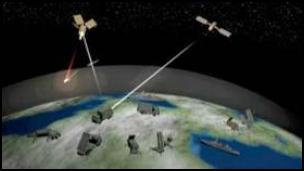NATO: First Step on Theatre Ballistic Missile Defence
NATO achieves first step on theatre ballistic missile defence capability
Press Release (2011) 009
Issued on 27 Jan. 2011
On 27 January 2011, NATO’s first ever theatre ballistic missile defence (TBMD) capability has been handed over to NATO’s military commanders. The handover took place at the NATO Combined Air Operations Centre (CAOC) in Uedem, Germany, in the presence of NATO Deputy Secretary General, Ambassador Claudio Bisogniero, and civil and military authorities from NATO and host nation Germany. The NATO Combined Air Operations Centre demonstrated how this interim capability allows NATO commanders, for the first time ever, to do limited ballistic missile defence planning and exchange information with national ballistic missile defence assets.
“The handover of this interim capability marks an important step in NATO’s missile defence efforts,” said Ambassador Claudio Bisogniero. “In line with the NATO Lisbon Summit decision, this capability will be further expanded to form the cornerstone of a future missile defence system for the protection of territory and populations.”

“NATO
commanders now have for the first time an initial, limited
but integrated ability to manage a defence battle to protect
deployed forces against ballistic missile attacks,”
said Brigadier General Alessandro Pera, Head of the Active
Layered Theatre Ballistic Missile Defence (ALTBMD) Programme
Office. During a short ceremony, he handed over the
capability to Major General Mark F. Ramsay, Deputy Chief of
Staff Operations & Intelligence, representing the Supreme
Allied Commander Europe (SACEUR) as the operational user of
the capability.
A rigorous ‘ensemble’ test, held from 6 to 10 December 2010 at the Integration Test Bed hosted at the NATO Consultation, Command and Control Agency (NC3A) facilities in The Hague, verified the ability of the NATO Command and Control system to connect and direct a multinational coalition of weapon and sensor systems in a missile defence battle.
“This interim capability meets a first batch of military requirements and was delivered in time and within the budget envelope. It is a good example of phased programme implementation under the auspices of the Conference of National Armaments Directors (CNAD), combining NATO and national assets in a common architecture” said Patrick Auroy, NATO Assistant Secretary General for Defence Investment and Chairman of the CNAD.
A Field Test followed immediately after the Ensemble Test at the capability’s first deployed location, the NATO Combined Air Operations Centre in Uedem, Germany. These two tests were the last in a series of tests of this interim capability, which also included ‘live fire’ tests off the coast of Crete, Greece in 2009. “The performance of the capability met its military requirements,” added General Alessandro Pera.
Weapon and sensor systems from five Allies – France, Germany, Italy, the Netherlands and the United States - took part in the Ensemble Test, along with the NATO operators who will be using the capability.
This is an example of successful collaboration under the ALTBMD Programme Office, involving Allies, NATO military commanders, NATO Agencies such as NC3A and NACMA (NATO Air Command and Control System Management Agency), and the industry.
Under the ALTBMD Programme, NATO provides a command and control system that links sensors and interceptors from Nations into a capability that can protect deployed forces from ballistic missile attacks.
The ALTBMD Programme Office will continue to upgrade the NATO Command and Control System for Theatre Ballistic Missile Defence in incremental steps from 2013 to 2018, to field a more robust Final Operational Capability. In line with the Lisbon Summit decision of November 2010, the ALTBMD capability will also be expanded to protect not just deployed forces, but NATO European territories and populations as well.
ENDS


 Save The Children: MYANMAR - Heavy Rains Heighten Risk Of Disease Outbreaks Following Earthquake
Save The Children: MYANMAR - Heavy Rains Heighten Risk Of Disease Outbreaks Following Earthquake UNICEF Aotearoa NZ: Aid Cuts Threaten Fragile Progress In Ending Maternal Deaths, UN Agencies Warn
UNICEF Aotearoa NZ: Aid Cuts Threaten Fragile Progress In Ending Maternal Deaths, UN Agencies Warn Médecins Sans Frontières: Concern Over Planned Deportation Of Afghan Refugees In Pakistan
Médecins Sans Frontières: Concern Over Planned Deportation Of Afghan Refugees In Pakistan European Cultural Centre: Time Space Existence 2025 - A Collective Call To Repair, Regenerate, And Reuse
European Cultural Centre: Time Space Existence 2025 - A Collective Call To Repair, Regenerate, And Reuse John P. Ruehl, IMI: What Will Tech Moguls Do With Their Wealth?
John P. Ruehl, IMI: What Will Tech Moguls Do With Their Wealth? ITUC: Workers Must Not Pay The Price Of An Imposed Trade War
ITUC: Workers Must Not Pay The Price Of An Imposed Trade War